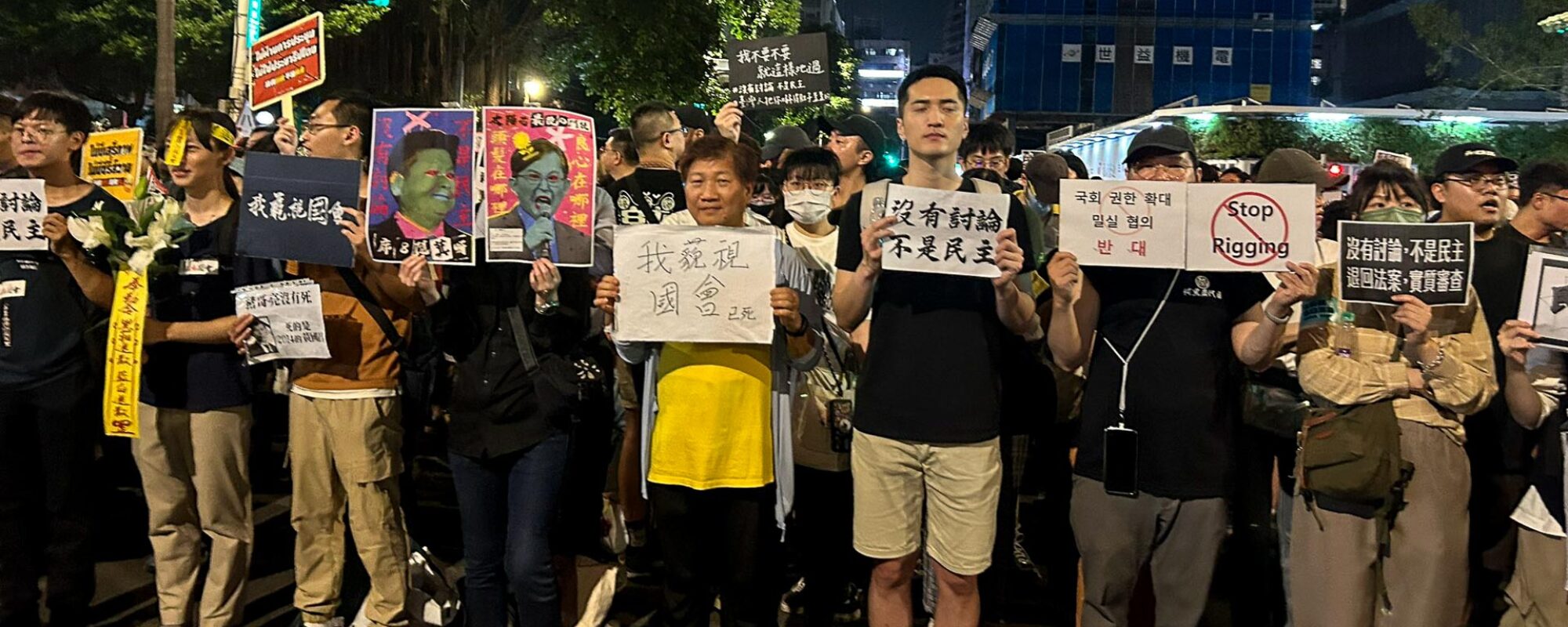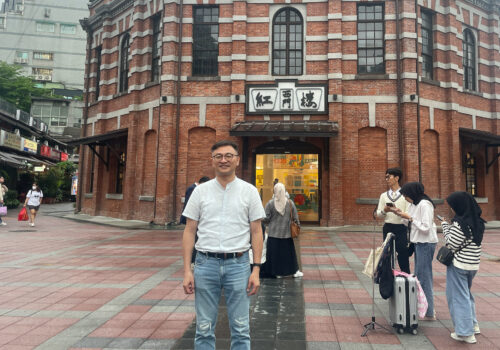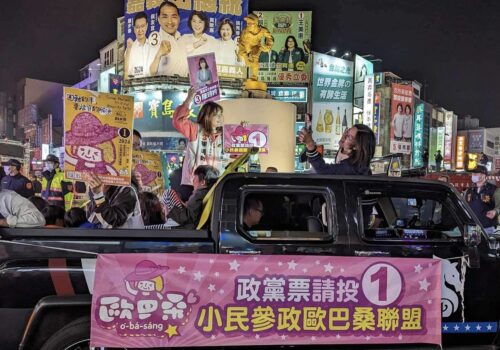TAIPEI — From a sea of red stools and makeshift signage—meme printouts in sheet protectors, words outlined in tape affixed atop umbrellas, cardboard collages of stickers and original artwork—a middle-aged woman stood up abruptly.
“Taiwan, we must protect our democracy!” she said.
Dressed in a frilly polka-dot blouse and beige bucket hat, her entire upper body leaned forward as she shouted. Her eyes scrunched shut, as though in desperate prayer that her voice would resonate into the Legislative Yuan (or Taiwan’s parliament) building. A frail man—a relative, I assumed—reached up from his seat and gently slapped her forearm.
In the woman’s quick swivel to face the man, our eyes met briefly across 15 meters and past the roughly 100 people between us. Amused by her outburst, I bumped my fist a couple of times in her direction and smiled back.
Over the cacophony of competing megaphones, volunteers encouraging people to stay hydrated and the chatter of tens of thousands of demonstrators gathered outside the Legislative Yuan building, I could just hear her excitedly saying to the man, gesturing at me: “Look! That young man is paying attention to me! The future of Taiwan is paying attention!
“Young person,” she turned back to me. “Keep fighting!”
Pulled away by a very orderly and constant stream of people ushered forward by volunteers, I didn’t see that woman again. Or perhaps I did, somewhere in the crowds during the three days of mass demonstrations in late May that kicked off Taiwan’s Bluebird Movement (qingniao xingdong). At its height, more than 100,000 people gathered to protest a joint attempt by the Chinese Nationalist Party (KMT) and the Taiwan People’s Party (TPP) to push through parliamentary reforms that expand the Legislative Yuan’s powers, via the Act Governing the Legislative Yuan’s Power (lifayuan zhiquan xingshifa) and Taiwan’s criminal code.
KMT and TPP legislators argue the reforms are designed to “balance the dominance of the executive branch,” noting similarities with US policies as well as past reforms proposed by the opposition Democratic Progressive Party (DPP). In a recent video posted on the KMT’s official Instagram account, a supporter sporting a delivery driver’s shirt says, “Parliamentary reform is a non-partisan issue. The DPP can use these same policies when they are not the ruling party.”
But demonstrators and commentators in Taiwan and abroad worry not only that the law may threaten Taiwan’s democratic stability but also that its hasty passage presages a potential pattern of procedural manipulation over the next four years, in a parliament where the KMT and TPP have a numerical advantage over the DPP.
Indeed, The Diplomat published an open letter from nearly 30 international academics, journalists and diplomats—including two former directors of the American Institute of Taiwan, the de facto US embassy in lieu of diplomatic relations—expressing “strong concern and disappointment” that the reforms “are potentially unconstitutional and an usurpation of political power.” On the ground, hundreds of speakers took to the demonstrations’ main stages and impromptu pickup-trucks-turned-soapboxes-with-megaphones from 9 a.m. until midnight on May 21, 24 and 28 to amplify sentiments such as disdain for the KMT and TPP and concern for Taiwan’s democracy and future.
Even if I did not see that woman again, across three city blocks in a major throughway in central Taipei, I heard voices like hers at every turn. Impromptu orchestras and drum circles set the rhythm for pedestrian traffic, with children pulling their parents in to dance. Along street curbs, DIY screen-printing and origami-folding stations provided quieter respites. The music collective Rave Fun Taiwan set up a DJ booth, spinning techno and house beats from sunset into the night.
The streets had been transformed into a world rooted in the Taiwanese people’s will and political ambitions, its geography of sounds and sights evolving with the crowds at any given moment.
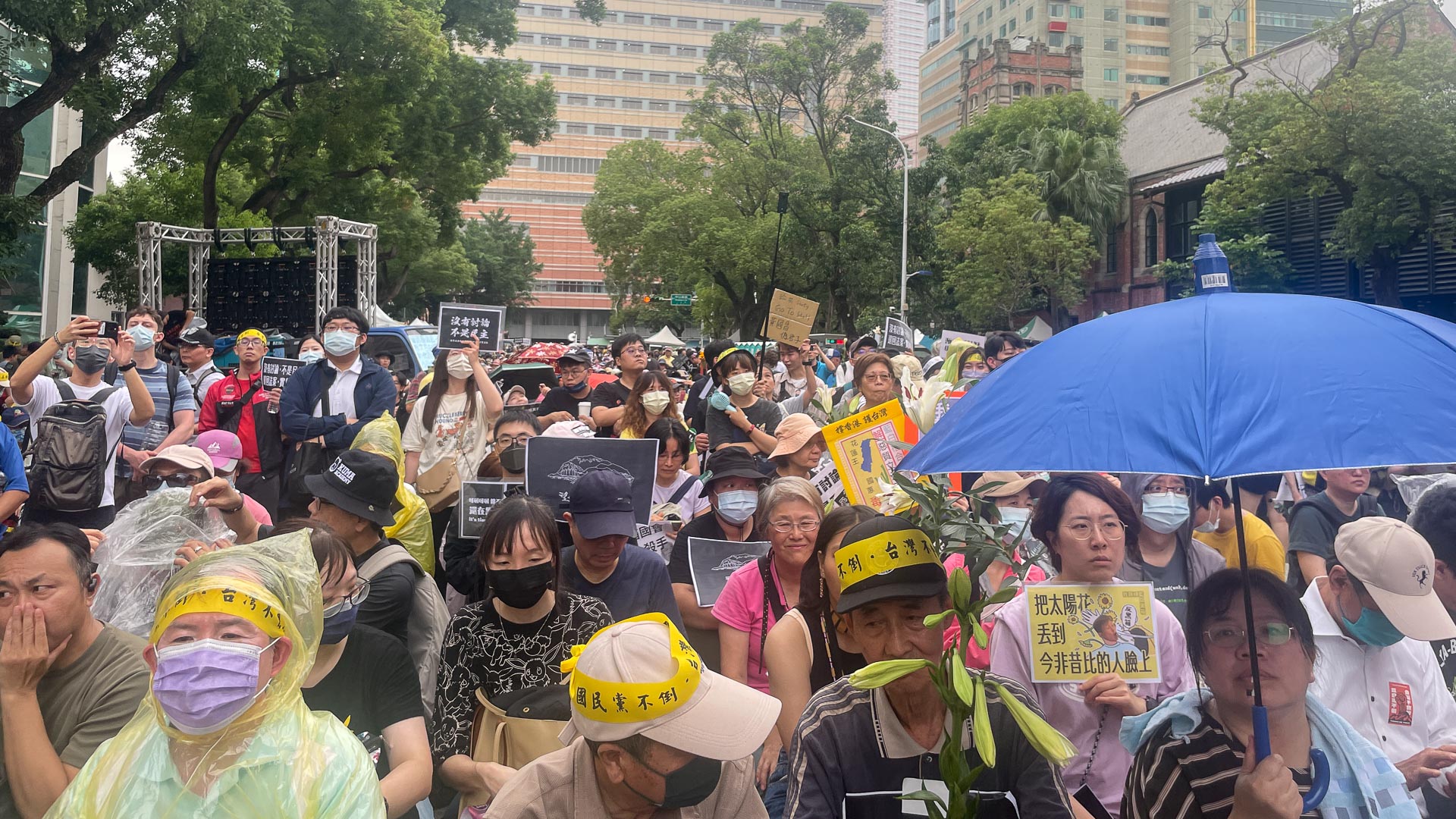
While the bill has officially passed as of late June—though the DPP immediately announced it would propose a constitutional review, which can temporarily sanction a bill’s implementation by six months—what stays with me is how quickly and wholeheartedly the Taiwanese people carried forward a robust legacy of mass demonstration.
And in an era when protest is increasingly criminalized, how precious it is to retain the opportunity to do so.
Inside the Legislative Yuan: context for the mass demonstrations
On May 17, just days before President Lai Ching-te’s inauguration, six legislators were hospitalized during a day of heated debate and physical clashes in the Legislative Yuan. Videos of legislators climbing over tables and wrestling with one another quickly flashed around the world. Zoom in further and you might see legislators angrily wagging their fingers, chests puffed, threatening and screaming.
Taiwan’s legislature has a history of emotional and aggressive sessions, but this fight was unprecedented in its intensity, with ambulances on the scene well into the night. The bill’s controversy rests both in its expansion of the legislature’s investigative powers over governmental and other activities, which many in opposition argue lack necessary checks and balances, and the way the bill was passed.
First, the bill demands the president deliver a mandatory state of the union address to the Legislative Yuan at least annually. After the address, the president must provide “real-time” answers to legislators’ questions, with no stated limits on what policy areas or subject matters are permissible. Scholars at progressive legal think tanks believe that would be used to subject the president to the will of the parliamentary majority. In a media environment fueled by negative attention, any attempt to dodge questions could lead to charges the president is hiding something.
Second, the amendments expand the Legislative Yuan’s investigative powers beyond its current right to access official documents and question central governmental officials. Under the bill, legislators could summon anyone before an ad hoc investigative panel. Refusing to attend or respond promptly could result in fines of up to 100,000 New Taiwan Dollars (NTD) or $3,100 per offense, while providing false information could be fined up to 200,000 NTD ($6,200).
The investigative group’s chairperson would have the power to decide if an individual’s reason for noncompliance is valid. If not, the chairperson could fine and hold the individual in “contempt of the legislature”—a criminal offense punishable by up to one year in prison. Moreover, a summoned individual could only be accompanied by a lawyer with the chairperson’s permission.
Many commentators argue the vague bill demands further deliberation by lawmakers. At a May 23 press conference by the KMT, a Deutsche Welle reporter asked KMT legislator Wu Tseng-hsien to define “reverse-questioning,” which individuals would be prohibited from doing under the new bill. He replied they would “explain it to the public after the law is passed.”
Over 100 legal experts and scholars published an open letter stating the bill contains “numerous uncertainties [… and even] clauses that conflict with each other. Their future application would result in many disputes and infringe on citizens’ basic freedoms and rights.”
Beyond the bill’s contents, many people were angered by the “procedural violence” (chengxu baoli) behind its hasty passage. The night before the beginning of the May 17 review process—in which each clause and article of a bill is meant to be read aloud, substantively deliberated and voted upon by the entire parliament—the KMT and TPP used a “motion to amend” technicality to put forward a new version of the bill. Due to this technicality, the bill’s sponsors are not obligated to post the text of the bill on the Internet prior to deliberations, which DPP legislators described as an act of bad faith and “black box” (heixiang), or opaque, politics.
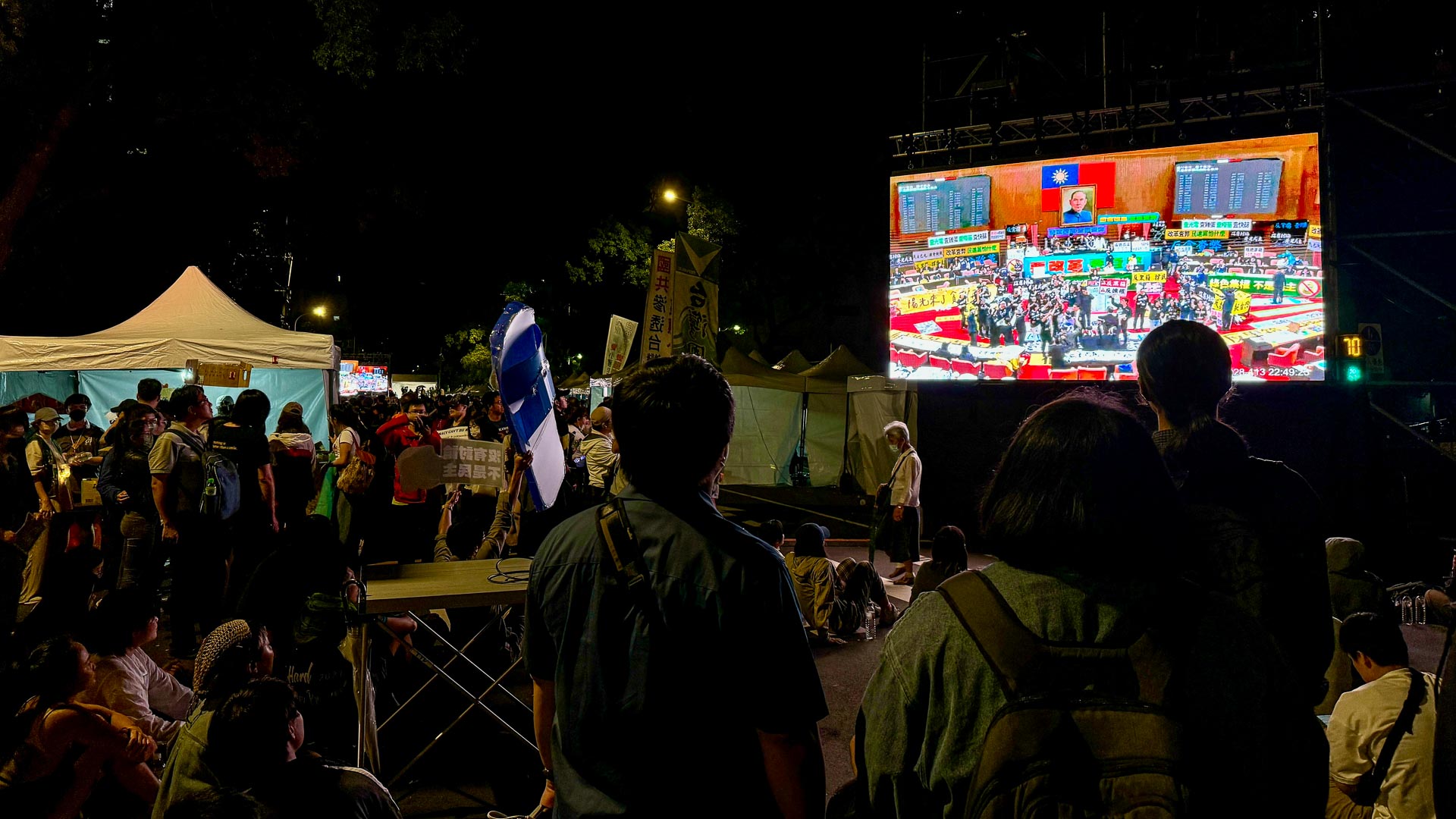
The opposition lawmakers said they had been completely frozen out of the deliberation process leading up to the bill’s review. The KMT, however, claims there was plenty of opportunity for discussion; leading up to May 17, they arranged a special report meeting, a public hearing and two bill review meetings. The nonpartisan NGO Taiwan Factcheck Center clarifies that these meetings are consultative rather than discussion-oriented, and while the KMT did host article-by-article reviews of previous versions of the bill before May 17, the DPP’s propositions were never taken into consideration.
“In a highly confrontational atmosphere, it is difficult to have a truly rational discussion, which is indeed a political tragedy,” the center wrote.
Once readings of the bill began, rather than open the floor to all legislators for debate, Legislative Speaker and KMT legislator Han Kuo-yu opted out of established procedures. He declared that each political caucus could only send one representative speaker, who would then be limited to a one-time speech of three minutes per article. With each impassioned three-minute speech, the DPP rotated among its legislators, many of whom wore matching black shirts and headbands with slogans like “Democracy is dead!” or “Oppose the black box!”
Each article passed by majority vote with no further debate. Here, Han decided to conduct the vote by a show of hands—an often-unused, though entirely legal technicality—rather than using the voting machine at each legislator’s seat. Observers note that Han’s use of the technicality allowed the KMT to crowd around Han at the rostrum, forming a human shield against the DPP should they attempt to occupy it.
At one point, DPP legislators hauled blue plastic bags—filled with crumpled copies of the proposed bill emblazoned with the word “garbage” (le se)—to the KMT stronghold while KMT members defended themselves with sun-shaped balloons and cardboard signs that promised to expose “fraud and corruption.” Much of the KMT narrative around that event claims the DPP instigated violence. KMT legislator Chen Ching-hui, at the aforementioned press conference, accused DPP legislator Chung Chia-pin of sexual assault.
Outside, however, demonstrators viewed the DPP’s cross-chamber sprints and antics as a last-ditch attempt to prevent the KMT and TPP from excluding them. Demonstrators saw the procedural shifts as yet another example of black-box politics; under this voting method, legislators’ names are not recorded, so history has no way of judging them.
That call to oppose black-box politics directly evokes the 2014 Sunflower Movement—the last major mass demonstration to rock Taiwan. Just over 10 years ago, hundreds of students and civil society activists occupied the Legislative Yuan to protest the then-KMT government’s attempt to pass a trade deal with the Chinese government without clause-by-clause review. At its height, on these same streets, upwards of 500,000 people marched in the street and ultimately succeeded in scuttling the deal.
As in the events of 10 years ago, China looms large behind the current legislative debates. Han and Fu Kun-Chi, the KMT’s legislative caucus convener and co-author of the reform bill, are both perceived as having close ties with the People’s Republic of China. Indeed, at the end of April, Fu led a trip to China with 16 other KMT legislators, during which he met with Taiwan Affairs Office (TAO) Director Song Tao and Chinese Communist Party (CCP) chief ideologist Wang Huning.
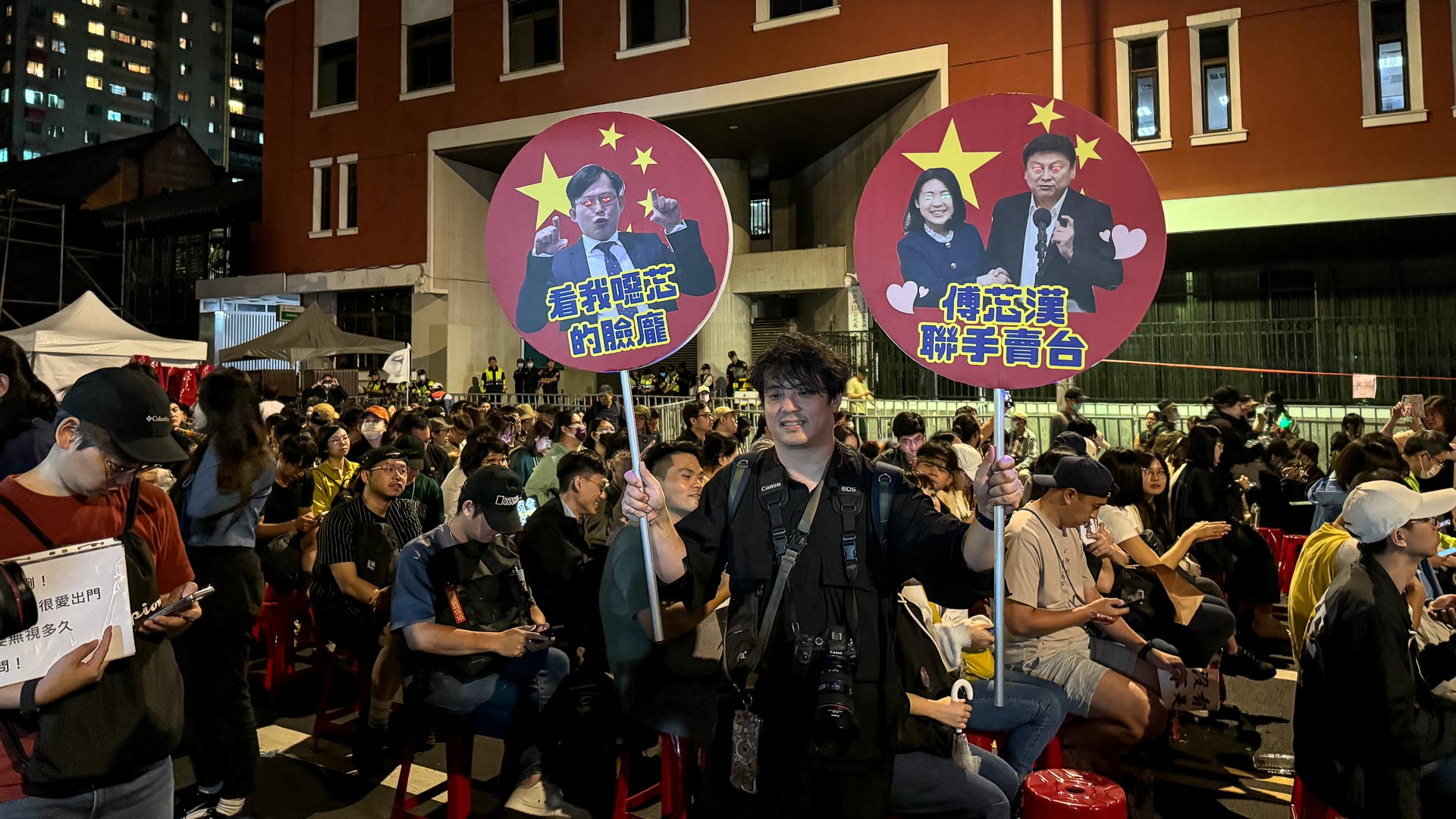
Given the recency of this trip and Fu’s key role in the reform bill, many worry the reforms may provide a pathway for the KMT to make national security and other crucial information available to the CCP. In the streets, protesters consistently highlighted China’s attempts at informational, commercial and social warfare toward Taiwan, citing how everything from Douyin (the Chinese edition of Tik Tok) to business relations to exchange students can become avenues for infiltration.
In the end, after four day-long sessions filled with impassioned speeches from the DPP and a legislative chamber festooned wall-to-wall with banners from all parties, the KMT and TPP emerged victorious. On May 28 at 10:53 p.m., the bill was voted forward by a show of hands in what the KMT and TPP declared was the beginning of the “Sunshine Legislature” and what the DPP declared a dark day in Taiwan’s history.
Order in the streets: an exercise in world-building
When I arrived at the demonstrations around noon on May 21, just a couple hours after they had kicked off, light rain was beginning to sprinkle over the 1,000 people huddled outside the Legislative Yuan. An LED screen spanning the width of Qingdao East Road stood at the far end of the block, showing live footage of the Legislative Yuan’s happenings. A giant canopy tent shielded most of the demonstrators scattered along the street, standing or sitting on rows of red stools. Smaller tents lining both curbs and sidewalks provided cover for medics, media workers and volunteers distributing free snacks, water and ponchos for demonstrators. Flags as tall as telephone poles, representing some of the NGOs and small political parties leading the demonstrations, rippled with the gentle breeze at the entrance of the street, demarcated with safety barricades.
The demonstrations were organized by the Taiwan Economic Democracy Union (TEDU), a coalition of civil-society organizations that formed on the eve of the 2014 Sunflower Movement. While TEDU livestreamed the main stages of the demonstrations, provided commentary throughout and coordinated much of the volunteer engagement, other organizations shared the stage or occupied space elsewhere in the crowds that soon flooded the streets in a largely decentralized and multilateral effort to oppose the reforms. As Lai Chung-chiang, TEDU’s convener said at a press conference: “We are independent citizens of Taiwan. We did not assemble here because political parties called us, nor will we leave because they dissuade us.”
At first, on a Tuesday afternoon, the crowd seemed to consist of college students, elderly folks and passersby on their lunch breaks. At this point, most people’s attention was directed toward the LED screen and the speakers onstage: NGO representatives spanning all issue areas, political firebrands like Taipei city councilor and Social Democratic Party representative Miao Poya and celebrities like drag queen and RuPaul’s Drag Race winner Nymphia Wind. The vibe was reminiscent of an outdoor lecture hall, with the speakers asking yes-or-no questions (“Is this the democracy we want?”) or leading call-and-responses with slogans like: “Without discussion, there is no democracy!” (Meiyou taolun, bushi minzhu)
When I returned in the evening, even as torrential rain pelted the street, the crowd swelled past the barricades and out onto Zhongshan South Road. Once the rain began to subside, a cheer echoed off the Legislative Yuan each time a new participant count was announced and the demonstration’s perimeter expanded.
Later that night, the first soapboxes emerged in places where speakers from the main stage could not be heard. While the speeches on the TEDU-organized main stage were educational or advocacy-oriented, often touching on the bill’s implications, the soapboxes were personal and emotional.
A college student from Kaohsiung who had taken the high-speed rail to the capital as soon as her classes ended spoke of her building anxiety about Taiwan’s future.
A Taipei-based office worker amplified the betrayal that she and so many felt from Huang Kuo-chang, a leader of the Sunflower Movement and current TPP legislator who submitted the final version of the reform bill.
Atop a soapbox truck, an impassioned demonstrator shouts words she wishes to tell her father, who voted for the TPP in the most recent election: “Look, the party you voted for is collaborating with the party you hate most. Now what?”
A young man described his PhD research tracing the lives of Sunflower Movement activists and refuted the idea that the movement’s legacy is over. While many still carry deep traumas from the police brutality and political opposition they faced 10 years ago, he said, many still feel a deep obligation to protect Taiwan.
An octogenarian spoke in Taiwanese Hokkien about how she had flown back from her retirement home in Brazil after May 17 because of concern for her homeland.
Some speakers were relieved to find like-minded company. Others shared tips about how to communicate with friends and family members with different political views and affiliations. Anger and betrayal raged in condemnations of the KMT, TPP and even the DPP. Indeed, while the protests were supportive of the DPP’s opposition to the bill, most people I spoke with denied this was a partisan event; rather, it was about democracy.
Even offstage, I heard friends and strangers discussing the political system, local political issues and legal frameworks. As the protests continued to grow, various local contingents created flyers and pamphlets explaining inequitable or corrupt policy developments in places like Hualien or Keelung, which are largely represented by KMT legislators.
The streets provided a platform, literal and metaphorical, for people to express their political ambitions within the movement’s decentralized diversity. At first, it felt as though hatred or betrayal were the dominant emotions of the early days. Throughout the demonstrations, whenever Han was projected onto the LED screen announcing the successful vote of yet another article, the crowd broke into a garbled cacophony of shouts and jeers.
Moreover, plenty of artwork and signage condemned the activities of KMT and TPP politicians. For example, tombstones were created for Huang Kuo-chang from 2014, when he stormed the Legislative Yuan with the spirit of student protest and pro-Taiwanese sentiments. Many memes and comic strips depicted Huang and major KMT legislators—Fu, Han and Hsu Chiao-hsin, among others—in cahoots with the CCP, literally illustrating the oft-used Taiwanese phrase tian gong, translated literally as “licking the CCP” or kissing up to the CCP.
Most of the condemnations ended in the same refrain: Step down. You are out of place.
But as the participant count climbed, it became clear the speeches that received the most applause were those emphasizing that the citizens are the masters of Taiwan’s democracy. Crowds expressed appreciation for the effort people made to be at the protests—traveling from abroad or other Taiwanese cities, arguing with parents or family members who deeply support the KMT or TPP, spending the whole day at the demonstrations. At a soapbox organized by National Taiwan University students, organizers reminded speakers their only rules were to “find solidarity within our differences” and avoid discriminating against anyone based on sex, gender, ethnicity or ability.
Indeed, beyond a shared love, belief or at least curiosity toward Taiwan’s future, it feels difficult to pinpoint who the protesters—spanning generations, geographies, genders, educational backgrounds and socioeconomic classes, among other identity markers—exactly are. Space was respectfully offered to differently abled folks in wheelchairs; people frequently stopped to take pictures of artwork connecting democracy with the rights of gender and sexual minorities; older speakers received as much applause as younger folks did.
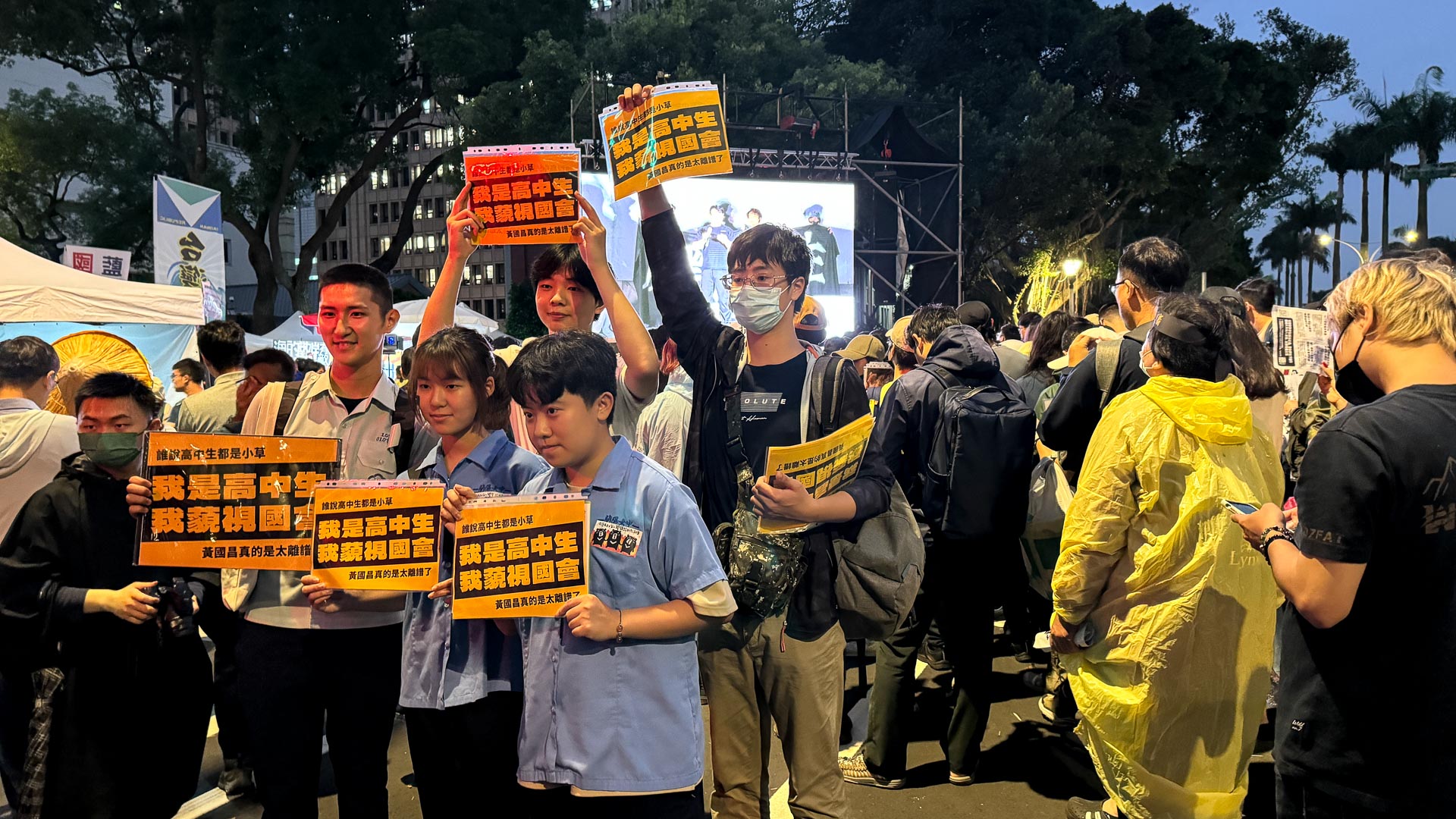
At one point, I stood next to a group of uniformed high school students who clutched each other’s backpack handles so as not to become separated in the streams of people. One survey estimated that approximately 10 percent of protesters across the three days were high school students. They distributed orange signs to other high school students that read, in bold font, “We are high school students, and we condemn the parliament!”
“After hearing so many elders and activists speak, I realized that my views are similar to theirs, and I’ve been building up my courage to maybe go up too,” one high schooler, taller than I and sporting a buzz-cut, said.
“Do you want to go? Let’s go together!” said one of his friends, grabbing his shoulder.
They gave me one of their posters and ran off to the nearest soapbox line.
At the end of the first mass demonstration on May 21, which grew to 30,000 people at its peak, the TEDU organizers announced a new strategy. If we want to maintain pressure on the KMT/TPP, they said, we need to make sure our numbers grow.
They encouraged supporters to rotate taking time off work based on the last digit of their ID number and attend the next demonstrations. For May 24, supporters with an odd final digit should request a vacation day as soon as possible. For May 28, supporters with an even final digit should take their turn. And repeat this process for as long as needed.
Although it’s unclear how many people actually adopted this strategy, a new world unfurled on Friday. Soapboxes multiplied. Some were elevated on political campaign vehicles. Pickup trucks were repurposed. Che-Lam Presbyterian Church, located on the same block as the Legislative Yuan, became a primary service hub, opening its pews for the elderly and others to rest indoors and its premises for the distribution of hot porridge, water, snacks, first-aid supplies and more.
Tents were set up along the perimeter of the demonstrations for folks to drop off donated goods: boba orders, hot bento boxes for lunch and dinner, cartons of water bottles and sports drinks, garbage bags full of biscuits and other dry snacks. TEDU volunteer organizers shared Google Sheets across Threads, Instagram and Facebook that constantly updated what the demonstrators needed. At any given moment, volunteers onstage and at those tents were reminding people to take care of their bodies first and foremost, handing out water bottles with gentle encouragements of “Xin ku ni le”—a phrase of care that translates to, “You have gone through great trouble to be here.”
Groups of parents set up childcare tents. While some mothers breastfed, others hosted educational circles to teach young children about the demonstrations. The sessions were led by the Taiwan Obasang Political Equality Party and the Association of Participatory Parental Education in Taiwan.
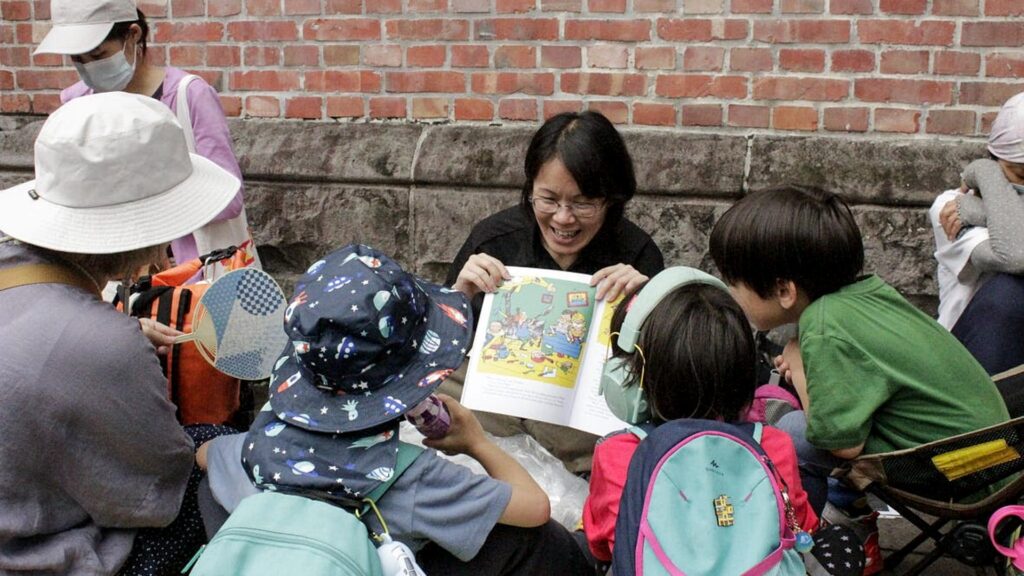
One mother, Mrs. Chen, looked on as her 5-year-old and 6-year-old played with some new friends.
“Originally, I was worried about bringing young children to this event because of their safety but once I heard on social media that there were childcare tents, I immediately came over,” she told me. “I don’t think I would know how to talk to my kids about the events in the Legislative Yuan if it weren’t for the other parents here.”
The ethic of care resonated throughout all three days of demonstrations. Even when 100,000 people crammed into the space of five city blocks, they patiently waited for the traffic to move forward. Medics and volunteers with first-aid kits made constant rounds. Protesters took pictures of and cheered for one another’s signs, as others handed out stickers and trinkets. Local drag queens and indigenous artists organized their own shows, spread out just far enough to ensure their music didn’t overwhelm someone else’s. At dance cyphers, drum circles and open mics where people pulled up the lyrics to Cantonese and Taiwanese Hokkien protest anthems on their phones and sang along, I watched as strangers clapped and hollered and bolstered each other’s spirits.
I chatted with one of the dancers after participating in the cypher for a few minutes. I had seen him in some of the hip-hop classes I’d taken around Taipei and learned that he was an undergraduate at National Taiwan University. Dance and politics had previously always felt worlds apart for him, but this was different.
“I can see that I’m not alone as I try to piece together where dance, where I, can contribute to the budding, ongoing project of Taiwanese democracy,” he told me.
Innocence undone: the privilege of rehearsing a protest
By the final day of the initial demonstrations on May 28, it was clear the bill was going to pass. Although 70,000 people still stood outside the Legislative Yuan, the mood felt quieter, more pensive.
At the evening news conference, the demonstration’s organizers turned their messaging to the future. This was going to be a long fight, they emphasized. TEDU and its coalition partners urged the public to return to their local districts, build new networks or join existing ones and make their desires known to local politicians—especially if they live in districts represented by KMT legislators. Longtime activist and social movements observer Brian Hioe writes in New Bloom Magazine that similar messages were heard after the 2008 Wild Strawberry Movement, which protested the visit of high-ranking Chinese official Chen Yunlin, and the Sunflower Movement. Indeed, for many, the Bluebird Movement reinvigorated these movements as stages of the ongoing project of democratic progress rather than just dusty textbook paragraphs.
The weekend between the second and third day of demonstrations, at an outdoor pub, I reflected on the Bluebird Movement with a dear friend—a Hong Kong transplant living in Taiwan and a longtime activist on both islands. While sympathetic to the cause and concerned about the threats to Taiwanese democracy, he was skeptical of the demonstrations’ utility: “It feels like a rehearsal as opposed to a real protest.”
He articulated something I had long felt but did not know how to put into words. As I wandered in and out of the crowds for hours, I occasionally felt lost in a “Groundhog Day” simulation, as the same slogans, songs and commands to keep traffic moving were repeated over and over. On the fringes of the protest, most people were sitting on their phones, scrolling social media or watching the latest Korean drama, waiting for something—although no one knew what.
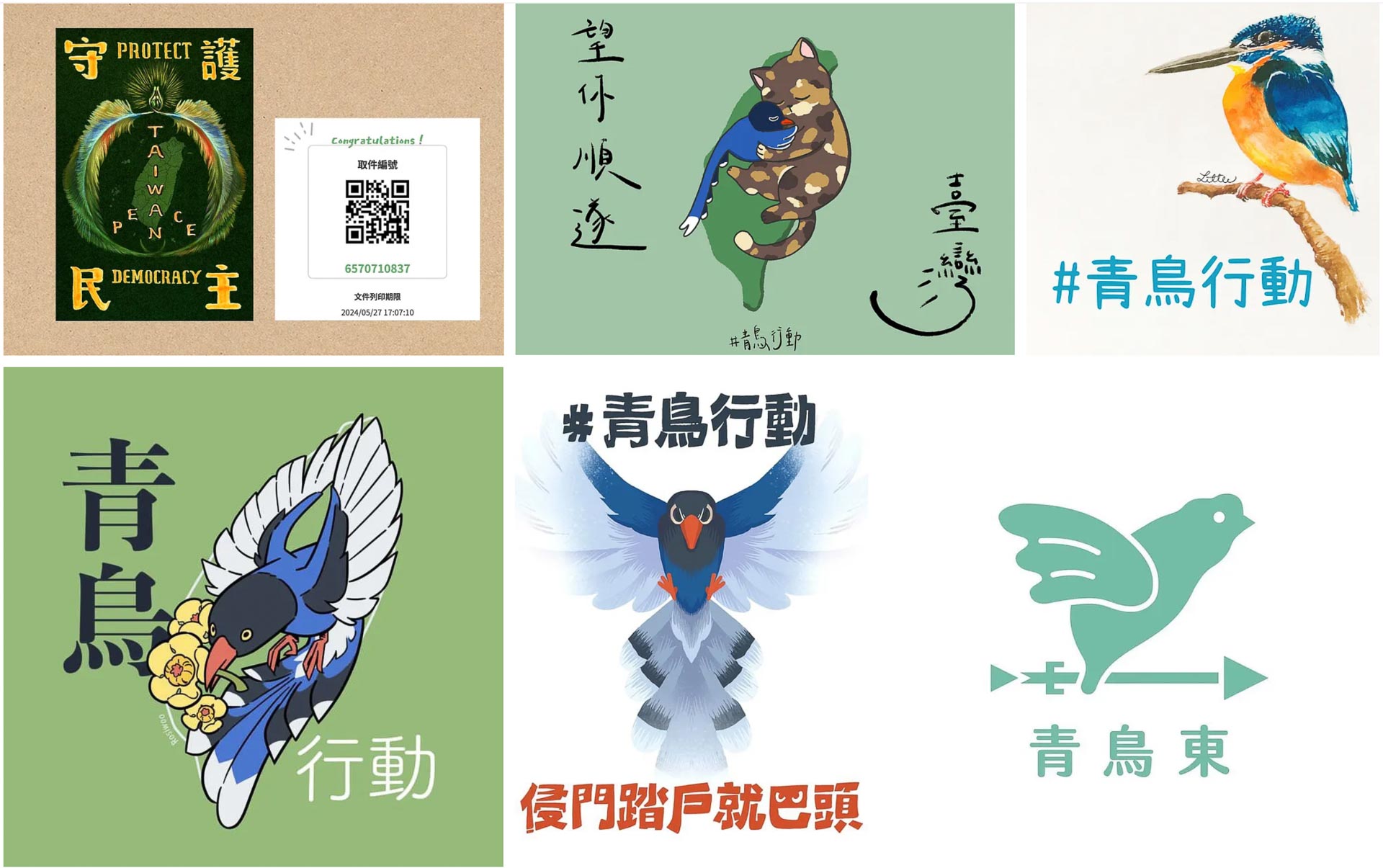
At the end of June, the bill went into effect after reviews by both the Legislative Yuan and Executive Yuan. DPP legislators and the Presidential Office have brought the bill before Taiwan’s Constitutional Court, as the next frontier to preventing the bill’s long-term implementation, while the KMT and TPP have begun to organize special investigative committees on a pro-Green media outlet as well as egg shortages, which they have long alleged is a result of DPP corruption.
Meanwhile, on the streets, the Bluebird Movement has continued to take flight. During the parliamentary reform amendments’ reconsideration review in the Legislative Yuan between June 19 and 21, TEDU hosted a “summer school teach-in” that attracted 30,000 participants. The demonstrations took on a similar form, with a collage of signage, care stations and speeches decorating the streets outside the parliament building. Since the bill passed, the movement’s rallies have begun to expand beyond focus on the KMT and TPP’s joint pursuit of new powers and into pan-Green causes such as protesting the renewal of nuclear power plants.
July’s demonstrations are mostly limited to taking place in the evenings or online news conferences, with much lower attendance. Some commentators consider the numerical decline as a sign the Bluebird Movement has not—and may not—leave its coop, weighed down by a lack of focus. Others say the summer will be a crucial time for the DPP and sympathetic actors to host summer programming that will sow the movement’s seeds, as occurred after the Sunflower Movement.
Each political party has continued to court public opinion with op-eds, reels and in-person campaigns across the country. An endless cycle of politics spins onward, which some worry may destabilize democratic deliberation and stoke polarization. Verbal attacks on parties and individual legislators continue in the media, even as both sides condemn the other’s smear campaigns. Starting in mid-June, the DPP and KMT began sending representatives and public figures to canvass at temples, streets and major public sites. TEDU has similarly begun to train volunteers to hold community dialogues and smaller-scale street demonstrations in KMT-led districts in New Taipei City and Keelung City. Although TEDU maintains its nonpartisanship and has expressed its intention to focus on swing voters, it also remains to be seen if it can sustain momentum amid the major parties’ campaigns.
Compared to the 2019 Hong Kong protests, in which 2 million Hong Kongers marched against leader Carrie Lam’s plans to allow extraditions to China, or the Sunflower Movement—both of which at least temporarily succeeded in their objectives—the Bluebird Movement seems to have settled into an inconclusive glide just above the ground, hopping upward at every opportunity it has.
During the first round of demonstrations, I ran into a dozen gay acquaintances sitting in overlapping circles in the middle of the street—part of the extended network of friends of friends that one meets at a gay bar. Dressed in neutral-colored tank tops, shorts and jeans, the entire group looked like it could hit the bars after the protests ended at midnight.
“It feels like a precursor to June Pride out here,” one said, joking. They had encountered plenty of other queer friends during the demonstrations.
“But I guess if anyone knows how to take to the streets en masse, it would be us,” a friend added. “After all, we do it every year.”
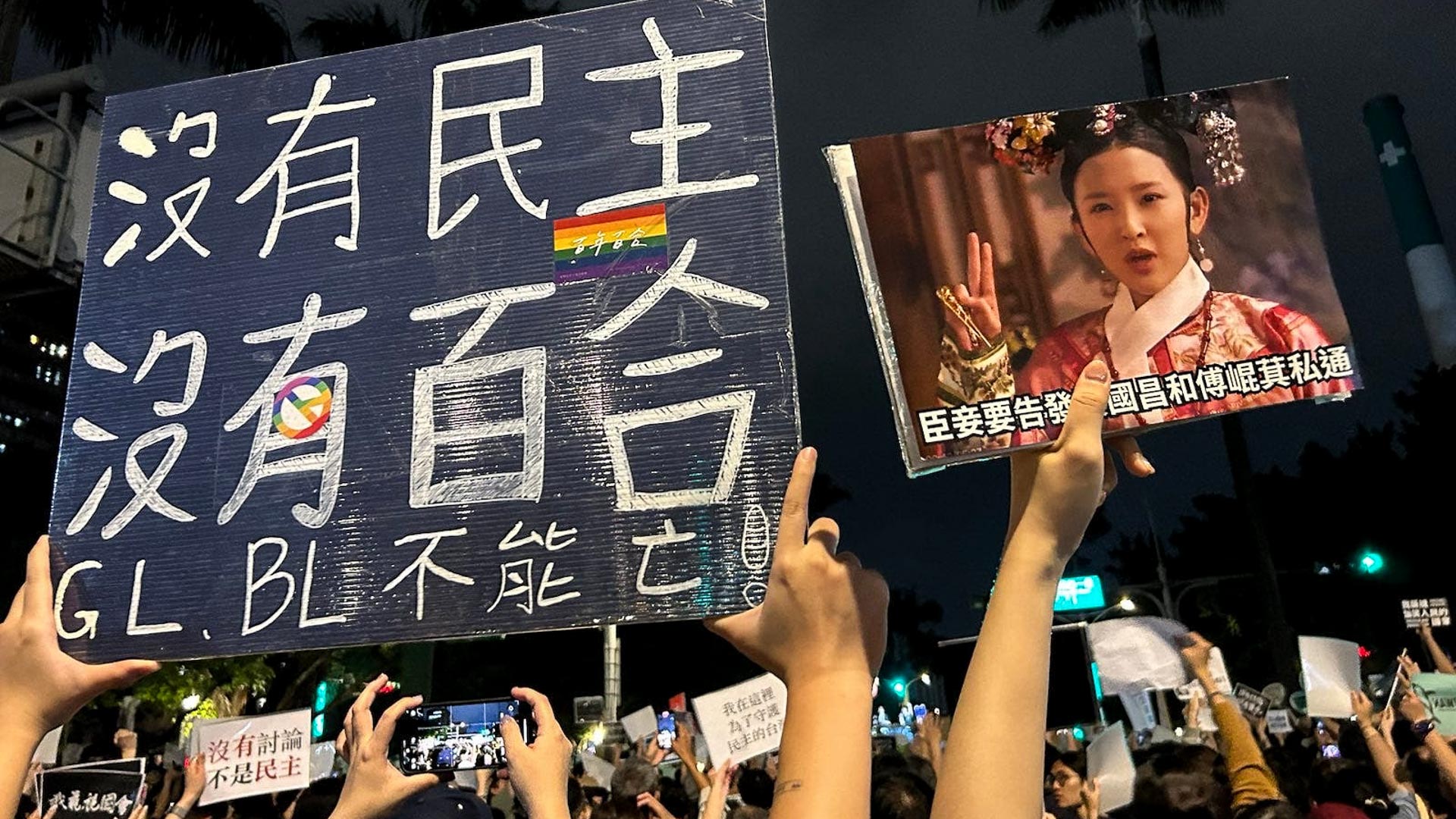
Of course, no one in the conversation seriously thought of Pride and the Bluebird Movement’s demonstrations as similar in nature or tone. But for many LGBTQ+ people, Pride de-risked and normalized the act of taking to the streets.
From the speakers and performers who occupied stages large and small to the volunteers who spontaneously set up childcare tents and storytelling sessions to the student-led soapboxes, the Bluebird Movement seems to have a similar effect. Without an immediate sense of crisis—as the dates for legislative deliberation and review were publicized and known from the beginning—people nevertheless quickly organized the infrastructure that underlies a protest movement, from first aid to media relations, traffic control to mutual aid.
Younger folks took to Threads, Meta’s text-based social-media platform, and Instagram chat rooms to coordinate spreadsheets of material needs. Organizers became more aware of all the roles and responsibilities required to control huge flows of people successfully. Organizations found new partners on the ground, accumulating the know-how of coalition work across issue areas and generations.
“Demonstrations are protests of innocence,” the late art critic and poet John Berger wrote in his 1968 essay “The Nature of Mass Demonstrations.” “There is an innocence to be defended and an innocence which must finally be lost: an innocence which derives from justice, and an innocence which is the consequence of a lack of experience.”
For the young people who did not experience the 2014 Sunflower Movement, for the layperson who did not previously know much about the Taiwanese legislative process, for the dancers and mothers who realized there are many others like them, that innocence has begun to unravel.
Pressed against the sweat-stickered skin of 100,000 other people gathered because of an interest if not a stake in Taiwan’s future, flags and neon-fluorescent boba-shaped fans tickling my head as they waved above the crowds, I stayed until the end of each night’s demonstrations from a feeling of responsibility to bear witness and a curiosity toward how this world of protest may continue to evolve. Caught in the streams of foot traffic during the height of the Bluebird Movement, I felt like I was no longer in Taipei but a virgin city, building itself up from the ground with the music, art and voices of the protesters.
As Italo Calvino writes in his novel Invisible Cities, “Cities, like dreams, are made of desires and fears, even if the thread of their discourse is secret, their rules are absurd, their perspectives deceitful, and everything conceals something else.” Here, in this imagined city bordered by safety barricades and traffic lights, Taiwanese people pieced together diverse visions for their future: calls for continued freedom set the urban plan, concrete place-based policy petitions filled in the grid and original artwork and rave music added color to the sidewalks. In the fever dream-like humidity, it felt almost unreal how many people had come out, time and again, to claim a vision for their political future.
Perhaps for more than any other reason, that is why I have come back to Qingdao East Road time and again. Here, I found myself among people who, across political issues and parties, across generations and geographies and other demographic divides, are searching for more precise means to not just participate in but actively influence Taiwan’s democratic experiment. I found camaraderie in the collective hope that the voices can indeed reach into the Legislative Yuan (and beyond) and alter the direction of the political future.
That is not to overestimate the Bluebird Movement’s potential impact. Lauren Berlant implored us not to confuse affective experience with concrete results in her 1999 essay “The Subject of True Feeling: Pain, Privacy, and Politics” when she asked: “What does it mean for the theory and practice of social transformation when feeling good becomes evidence of justice’s triumph?”
One night, after arriving home from the demonstrations a little after 1 a.m. with a 7-Eleven cold-cut sandwich and tea egg in hand, I began to flip through a sheet protector holding at least 10 flyers and 15 stickers I had collected over the day, printed and distributed by demonstrators. Most were expressions of Taiwan as their homeland, as a democratic and sovereign nation. One flyer was a page-long personal essay explaining the writer’s self-identification as a Taiwanese person rather than a Chinese one. Another documented the various policy changes a group of Keelung City residents hoped to push forward in their locale, with a QR code to a Google form petition they created. At the end of the its introduction, the organizers wrote that they would love to see responses from people don’t live in Keelung. “Let the KMT and TPP know that we are all watching, that we citizens know that our struggles and conflicts are all connected.”
By the time the red stools were stacked and last pieces of garbage were picked up at the end of each night of demonstrations in the last two months, triumph remained distant. But as anywhere from hundreds to hundreds of thousands of people huddled time and again under the cavernous echoes of their call-and-response shouts, the opportunity to graze hands and say, “Xin ku ni le” feels ever more precious.
Top photo: Bluebird Movement participants stand by the Legislative Yuan with signs condemning Taiwan’s recent parliamentary reforms

